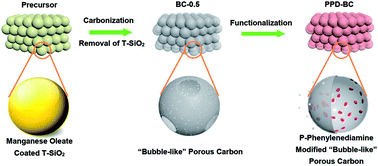Covalent grafting of p-phenylenediamine molecules onto a “bubble-like” carbon surface for high performance asymmetric supercapacitors†
Abstract
Traditional positive electrode materials consisting of transition metal oxides, sulfides, hydroxides, and conductive polymers exhibit ultra-high capacitances for asymmetric supercapacitors. However, negative electrode materials are rather poor. Herein, we report a simple but efficient template carbonization method to covalently graft p-phenylenediamine molecules onto a hollow “bubble-like” carbon sphere (PPD–BC) surface as the negative electrode for high performance asymmetric supercapacitors. In this strategy, the “bubble-like” carbon spheres can not only act as “reservoirs” to physically store pseudocapacitance additive p-phenylenediamine (PPD) molecules through a spatially constrained behavior, but also chemically confine the PPD using CO–NH chemically covalent bonds. As a result, the specific capacitance of PPD–BC (451 F g−1) is about three times higher than that of hollow bubble carbon (166 F g−1) due to the extra addition of faradaic reactions. More importantly, the as-assembled PPD–BC//Ni(OH)2 asymmetric supercapacitor exhibits a remarkably high energy density of 94 W h kg−1 at a power density of 423 W kg−1, as well as outstanding cycling performance with 88% capacitance retention after 1000 cycles. Therefore, the design of organic molecule modified carbon materials holds great promise for ultrahigh energy density storage devices.

- This article is part of the themed collection: Journal of Materials Chemistry A HOT Papers


 Please wait while we load your content...
Please wait while we load your content...